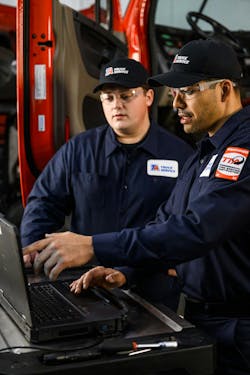Diagnostic tool use in commercial vehicle shops hits critical mass
This is Part One of a two-part story. Click here for Part Two.
Eight years ago, a commercial vehicle shop, on average, had one diagnostic tool per six technicians, according to Noregon Systems. By the end of this year, the diagnostic solution provider estimates the ratio will be 1:3.
Bruno Gattamorta, chief commercial officer for Cojali, which makes Jaltest diagnostic tools, thinks the ratio will be 1:1 by 2030. “You’re not going to be able to do anything without these tools in the future. As time goes on, there are more sensors and more ECMs,” he said.
With increased demand for maintaining and repairing more sophisticated commercial vehicle systems and components, in some places, a 1:1 ratio is just around the corner.
Butch Cassel, president of American Fleet Service, based in Portsmouth, Virginia, said the shop has one tool per every 1.5 techs. He’ll invest in additional tools if it takes too long for techs to get results—or if the shop picks up a new fleet customer with specific engines that need to be diagnosed. “Especially in a small, independent heavy-duty shop, there is a fine line to balance tool expense versus return,” he explained.
As fleets and maintenance managers plan their budgets for 2025 and beyond, it is a fine line they will walk all the same. The technicians will need to learn the basics of modern troubleshooting and have the tools necessary to do so unless they want to market themselves as a boutique antique truck repair facility.
A tech likely needs one of these tools for most jobs, from replacing a radio to an oil change (because they need to reset sensors). And because most systems communicate, the added wires, sensors, and processors may require some level of diagnostics.
“Most repairs use some type of diagnostic tool to verify the complaint, confirm the cause, or make the correction,” noted Dan Carrano, VP of fleet maintenance for A. Duie Pyle, a less-than-truckload carrier based in West Chester, Pennsylvania.
Daniel Mustafa, director of technical service for TravelCenters of America, said that over the past 20 years, electronics have been incorporated into virtually every vehicle system. “While this gives excellent visibility to vehicle issues, it makes electronic diagnostic tools a requirement for most vehicle systems,” he said.
This is true even in the body repair sector. According to Tom McGuire, CEO of Precision Diagnostics, a maker of tools for the collision sector, technicians can no longer “bare-knuckle” their way through repairs anymore.
Because advanced driver assistance systems (ADAS) are now integrated into many vehicles, diagnostic tools are now essential, even for simple tasks like replacing a windshield or bumper.
“Technicians today are working on computers, processors, and communication networks that are integrated into the vehicle architecture,” he explained.
No turning back
OK, so we know they’re needed. But what are these tools really providing, and why can’t we go back to those simpler, more analog times from two decades ago? For starters, all those additional sensors and ECUs paired with telematics lead to commercial vehicles producing and sharing more data than ever before.
So much, in fact, that “the vehicle itself is becoming a diagnostic tool,” said Robert Braswell, executive director of the American Trucking Associations Technology & Maintenance Council. “With telematics, you’re anticipating faults before they happen,” he said.
With the next stage in diagnostic evolution, predictive maintenance, AI programs can cross-reference a truck’s symptoms (or fault codes) against similar cases, alerting management when a truck might have to “call off” for health reasons. That gives you enough lead time to make changes and not disrupt operations.
Read more: Beyond fault codes: Modern remote diagnostics
But as you may have guessed when that truck rolls into the bay, “you need some sort of tool in the shop bay to figure out what is wrong,” Braswell said.
The best anyone could do without tools is guess at the root cause, Aaron McCoy, fleet performance manager for FleetNet America, said. “Not every failure or its cause can be directly seen or heard,” he said.
Diving in without a tool increases the odds that a customer will get their vehicle back with the same problem or even in worse condition. “That causes reputational damage not only to the technician but also the shop as a whole, and in some shops, [this] can even result in the technician being forced to work without compensation if they have to do rework or if they go over the quoted labor time,” McCoy said.
Danny Colon, co-owner of Dedicated Diagnostics, said the tools also save time, particularly when diagnosing complex, multi-system issues. He explained that JPRO’s enhanced fault guidance provides detailed, step-by-step instructions for diagnosing and repairing faults based on specific diagnostic trouble codes.
“This feature streamlines the diagnostic process, allowing our technicians to quickly identify and resolve issues without needing to consult multiple sources,” Colon explained.
Focus on techs
While the tools are becoming essential, they don’t replace the skills technicians need. “One of the big misnomers is you have this fancy robust scan tool that solves all the issues. It doesn’t, but it is a great data resource,” Precision Diagnostics’ McGuire explained. “The worst thing you can do is have really good tooling and underdeveloped technicians. We learned a long time ago that you have to marry the two.”
One of the challenges is that today’s trucks are getting more complex quicker than the fleet technicians can scale. “The issue is not just having the software and the laptop. It’s having techs who know how to use it,” said Aven Blozan, a technician for Iron Buffalo, which operates shops in Colorado and Montana, adding that techs also need to know when to question the data. “You can get led down the wrong path if you’re blindly trusting the information a tool is giving.”
As a result, training on tools and overall maintenance is essential. “The tool will lead you, but the fleet tech still has to make that final decision,” Carrano said. A. Duie Pyle taps into OEM training, creates handouts and training videos, and has trainers in the field.
With the ongoing technician shortage in the industry, shops must focus both on retention and recruitment.
“Having proper equipment and diagnostic tools available is a big factor in retaining experienced technicians and attracting new ones,” FleetNet America’s McCoy said. “As a technician, I frequently considered a shop’s tooling and equipment as a factor in whether I would accept an offer to work for that shop in the first place.”
Tools can also boost a technician’s confidence. “They might see 25 different brands of vehicles. They’re not going to know how to fix them all. We give them the step-by-step instructions on what they have to do to fix it, and then that, combined with their knowledge and experience, gives them the solution,” Gattamorta explained.
Mustafa added that some of the most sophisticated systems even offer just-in-time training specifically suited to the troubleshooting steps needed.
Cojali offers its customers access to advanced diesel technicians who can help other technicians over the phone. “When the user becomes the hero of the story and solves the problem, they become engaged,” Gattamorta said.
Because diagnostic equipment and tooling improves the ability of technicians to diagnose and repair customer vehicles, techs can make more money and experience fewer on-the-job frustrations. “There is an added advantage of the technician being able to educate themselves and improve their workmanship quality as they gain experience,” McCoy said.
Shops unable to invest in new scan tools or update existing software coverage often find their master technicians leaving in search of better work. “It’s unfortunate, but it is a story we hear more often,” said Fabio Mazzon, technical manager for TEXA USA.
Gattamorta pointed out that most technicians only use a fraction of what the tools are capable of, and it can be difficult for them to recognize they are not using the tools to their full potential. Technicians are offered weekly training sessions by Cojali, and customized training is available based on the requirements of individual shops.
For more on how diagnostic tools have evolved in functionality and accessibility, see Part Two of this story.

